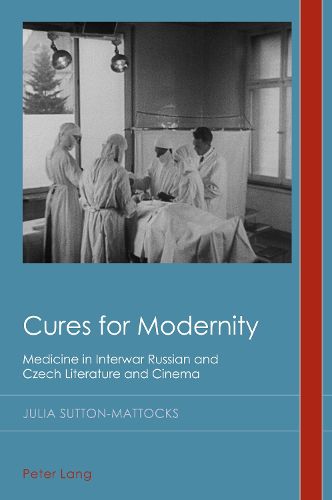Readings Newsletter
Become a Readings Member to make your shopping experience even easier.
Sign in or sign up for free!
You’re not far away from qualifying for FREE standard shipping within Australia
You’ve qualified for FREE standard shipping within Australia
The cart is loading…






This title is printed to order. This book may have been self-published. If so, we cannot guarantee the quality of the content. In the main most books will have gone through the editing process however some may not. We therefore suggest that you be aware of this before ordering this book. If in doubt check either the author or publisher’s details as we are unable to accept any returns unless they are faulty. Please contact us if you have any questions.
<>
(Melissa Miller, Modern Language Review 120.1, January 2025)
<>
(Dylan Mohr, Studies in Russian and Soviet Cinema 1-2, 2025)
Surgery, bacteriology, psychiatry ... medicine fascinated writers and filmmakers in the 1920s and 1930s. But why did medicine capture the creative imagination at precisely that moment, and what does the prevalence of medical imagery in works of the period tell us about interwar culture? These are the questions at the heart of this book, which takes the Russian and Czech literary and cinematic contexts as case studies for interrogating the wider phenomenon.
Contributing to an emerging body of scholarship bringing the Medical Humanities and Slavonic Studies into dialogue, the book focuses on four particularly prevalent medical themes in the literature and cinema of the period: syphilis, nervous illness, surgery and childbirth. It offers new perspectives on works by well-known figures of interwar Russian and Czech culture (e.g. Mikhail Bulgakov, Evgenii Zamiatin, Gustav Machaty and Vladislav Vancura) as well as familiarizing readers with more obscure works by some of their lesser-known counterparts, such as Vladimir Raffel, Vikentii Veresaev, Nikolai Aseev and Noi Galkin.
$9.00 standard shipping within Australia
FREE standard shipping within Australia for orders over $100.00
Express & International shipping calculated at checkout
This title is printed to order. This book may have been self-published. If so, we cannot guarantee the quality of the content. In the main most books will have gone through the editing process however some may not. We therefore suggest that you be aware of this before ordering this book. If in doubt check either the author or publisher’s details as we are unable to accept any returns unless they are faulty. Please contact us if you have any questions.
<>
(Melissa Miller, Modern Language Review 120.1, January 2025)
<>
(Dylan Mohr, Studies in Russian and Soviet Cinema 1-2, 2025)
Surgery, bacteriology, psychiatry ... medicine fascinated writers and filmmakers in the 1920s and 1930s. But why did medicine capture the creative imagination at precisely that moment, and what does the prevalence of medical imagery in works of the period tell us about interwar culture? These are the questions at the heart of this book, which takes the Russian and Czech literary and cinematic contexts as case studies for interrogating the wider phenomenon.
Contributing to an emerging body of scholarship bringing the Medical Humanities and Slavonic Studies into dialogue, the book focuses on four particularly prevalent medical themes in the literature and cinema of the period: syphilis, nervous illness, surgery and childbirth. It offers new perspectives on works by well-known figures of interwar Russian and Czech culture (e.g. Mikhail Bulgakov, Evgenii Zamiatin, Gustav Machaty and Vladislav Vancura) as well as familiarizing readers with more obscure works by some of their lesser-known counterparts, such as Vladimir Raffel, Vikentii Veresaev, Nikolai Aseev and Noi Galkin.